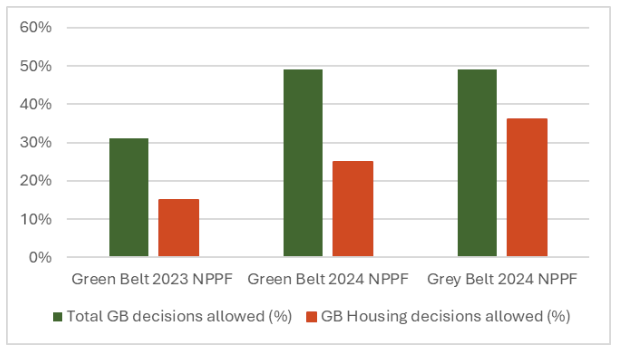New data analysis: Grey belt could ‘treble’ number of acceptable green belt sites
Planning | Blog
Grey belt policy could triple acceptable sites for green belt housing
Following the introduction of grey belt, our planning experts have conducted analysis indicating that 1 in 3 (36%) housing appeals on grey belt land have been approved and its usage has the potential to triple the number of ‘acceptable’ sites considered for local plans.
Key summary:
- 36% of housing appeals on grey belt land approved
- Grey belt policy could triple the number of acceptable sites
- Since the revised NPPF update, 49% of all green belt planning appeals have been allowed
- 60% of sites now fall into the “acceptable” category under new criteria
What is grey belt?
Grey belt is defined as land in the Green Belt comprising previously developed land and/or any other land that, in either case, does not strongly contribute to any of purposes (a), (b), or (d) in paragraph 143 of the NPPF.
What is green belt?
The fundamental aim of Green Belt policy is to prevent urban sprawl by keeping land permanently open, (paragraph 13, NPPF).
80 grey belt appeals
Overall 50/50 chance of success (for all uses)
Housing appeals – now around 1 in 3 chance of success (previously around 1 in 8). However most housing appeals e.g. 1 in 3 are minor applications, however we are seeing more and more major applications come forward.
What does this mean?
These findings point to a more flexible approach to planning decisions on grey belt land, potentially unlocking a significantly larger pool of sites for housing allocation within local plans.
Following the publication of the revised National Planning Policy Framework (NPPF) in December 2024, which launched grey belt policy, almost half (49%1) of all green belt planning appeals have been allowed, compared to just 31% in a similar period2 the year prior. Looking at housing appeals in isolation 25%1 have been successfully appealed, compared to just 15% the year prior.
The graph below shows decisions allowed between 12 December 2024 to 3 March 2025 for both green and grey belt applications, compared to green belt applications for the same length of time in the year prior2. The analysis shows that 1 in 3 (36%3) housing applications made on grey belt land were approved.

Historically, sites identified as ‘acceptable’ for consideration for development across the green belt were those that made a low or no contribution to the five green belt purposes4.
The introduction of grey belt, however, is set to increase the number of ‘acceptable’ sites three-fold as the new definition (Annex 2 of the NPPF) requires only the testing of three of the five green belt purposes and the level of contribution should not be ‘strong’.
Our analysis of three independent green belt reviews, undertaken before grey belt policy was implemented, show that, on average, 15% of sites make a low or no contribution to the green belt purposes, as shown in the table below.
| SADC5 | SCC6 | BCPCDC7 | Average % | |
|---|---|---|---|---|
| Strong | 113 | 89 | 70 | 42% |
| Moderate | 35 | 152 | 100 | 44% |
| Low or No | 34 | 33 | 28 | 15% |
| Total | 182 | 274 | 198 | n/a |
Under the new regime, whereby sites are deemed ‘acceptable’ if they offer moderate or low to no contribution, this skyrockets to more than 60%, meaning councils will have significantly more sites to consider in their local plans.
| Acceptable sites | SADC5 | SCC6 | BCPCDC7 | Average |
|---|---|---|---|---|
| Pre grey belt | 34 | 33 | 28 | 15% |
| Grey belt | 69 | 185 | 128 | 60% |
Planning director, Roland Brass, who led the analysis, said: “While the policy is still new and emerging, grey belt is proving to be a gamechanger, and it is having a significant impact on planning applications and local plans.
“Our analysis of planning appeal decisions and councils’ green belt reviews, including the Government’s recently updated guidance on the green belt, shows that the assessment process has become more objective. However, in practice, it remains subjective, as each site is assessed on a case-by-case basis and as a result there has been the odd inconsistent decisions.
“We are also seeing planning officers and members become increasingly confident calling sites grey belt as some major housing applications have been granted planning permission at the local level.
“The appeal decisions highlight the importance of achieving the golden rules around provision of affordable housing, infrastructure and open space so the benefits of grey belt also support communities meet local needs. Agreeing with a council that a site is grey belt can now significantly help de-risk and speed up the planning process to achieve a consent.”
To see all previous decisions, read our growing appeal of grey belt article.
What should local councils do now?
Local councils should act quickly to reassess their green belt land. Sites previously rejected for making a “moderate” contribution may now qualify as acceptable, significantly expanding land supply for housing. Local authorities are encouraged to update green belt reviews, integrate grey belt criteria into Local Plan updates, and engage with communities to identify sustainable development opportunities.
What should land developers do now?
Land developers should consider revisiting previously discounted sites and use the grey belt designation to strengthen planning cases. With inspectors increasingly open to well-prepared applications that deliver affordable housing and infrastructure benefits.
If you require any further assistance, we would be happy to assist you in refining and updating your strategy to align with policy changes and help you achieve your development goals.
1 Figures correct 03.03.2025.
2 (19th December 2023 – 10th March 2024).
| 3 Based on period of time from 12 December 2024 to 3 March 2025 (for similar 81 days from NPPF publication) | ||||||
| DECISIONS | ||||||
| 2024 NPFF – grey belt | 2024 NPPF – green belt | 2023 NPPF – green belt | ||||
| No | % | No | % | No | % | |
| Total | 30 | 70 | 84 | |||
| Allowed | 14 | 47% | 34 | 49% | 26 | 31% |
| Dismissed | 16 | 53% | 36 | 51% | 58 | 69% |
| Housing | 14 | 51 | 41 | |||
| Allowed | 5 | 36% | 13 | 25% | 6 | 15% |
| Dismissed | 9 | 64% | 38 | 75% | 35 | 85% |
4Purpose definitions:
- A) to check the unrestricted sprawl of large built-up areas;
- B) to prevent neighbouring towns merging into one another;
- C) to assist in safeguarding the countryside from encroachment;
- D) to preserve the setting and special character of historic towns;
- E) to assist in urban regeneration, by encouraging the recycling of derelict and other urban land.
Source Green Belt Reviews:
5 St Albans City & District – Green Belt Review, Stage 2 (2023) by ARUP.
6 Sheffield City Council – Green Belt Review Update (2024).
7 Bournemouth, Christchurch and Pool Council and Dorset Council – Strategic Green Belt Assessment, Stage 2 Harm Assessment, Final Report (2020) by LUC.
About Marrons
Marrons is a multi-service development consultancy backed by the experience of working for local authorities, extensive market intel and connections across the industry - from planning offices and private landowners to housebuilders and retailers.
With expertise in Planning, Architecture, Design, Heritage and Economic Development, you can trust us to lead, protect and enhance the value of your land or building assets ensuring we turn your plans into reality.
Talk to our Planning experts
We act on behalf of a range of clients across the UK to deliver economic, social and environmental regeneration. Our specialists are here you turn your vision into reality.
Our Latest Planning News & Updates
Our Areas of Expertise

Planning
Whether you are looking for advice on an appeal for a major development scheme, or putting in an application for a house extension, we can help you navigate the best way forward.

Architecture
Led by RIBA Chartered Architects, our Architects have wide-ranging experience in handling large scale projects through multi-disciplinary teams, often acting as project co-ordinators and design team leaders.

Design
Our urban design team have a wealth of experience in both large scale urban development and detailed design and can help you make the most out of your land and provide a clear vision for your development.

Heritage
Our heritage team proudly advocate for the role of heritage in sustainable place-shaping, and champion the value that heritage assets can bring to developments.

Economic Development
Our specialist team works with you to provide evidence that your land or planning development has commercial benefits, and positively impacts socio-economics in the wider community.






